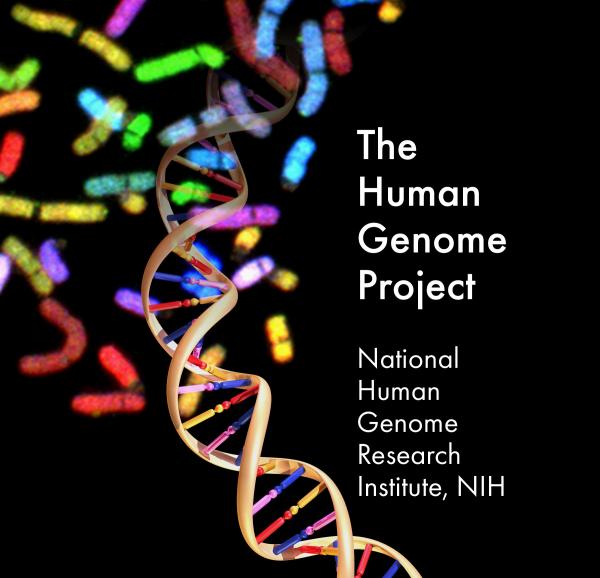NHGRI Director Eric Green Elected to National Academy of Medicine
Sequencing the Human Genome Sparks Transformation in Medicine

Dr. Eric Green, director of NIH’s National Human Genome Research Institute (NHGRI), was elected to the National Academy of Medicine in October 2023.
Few people can say they got in on the ground floor of a foundational achievement in science, but that’s where Eric Green, M.D., Ph.D., Director of NIH’s National Human Genome Research Institute (NHGRI), found himself when he began his career. It’s no wonder, then, that he was elected to the prestigious National Academy of Medicine (NAM) in October 2023.
Thirty four years ago, as a newly minted physician-scientist, Dr. Green joined the Human Genome Project, an initiative that had among its leaders former NIH Director Francis Collins, M.D., Ph.D. The initiative aimed to determine the order of the roughly 3 billion DNA building blocks, called nucleotides, that constitute the genetic blueprint for building and operating our bodies. Today, Dr. Green leads the NIH Institute that was established to lead NIH’s contribution to that ambitious endeavor, overseeing the investigation and application of information and technologies that drive the application of genomics to modern-day medicine.
Born into a family of scientists and physicians, Dr. Green suspected from an early age that he might find his way into a career in biomedicine. He completed his M.D. and Ph.D. degrees in 1987, just when the field of genomics — the study of all the DNA of an organism — was beginning.
“The word ‘genomics’ didn’t even exist until the year that I graduated with my M.D. and Ph.D. degrees,” Dr. Green says. “I had a vague idea that it might be a new and exciting frontier, perhaps one that would be ideal for me.”

Dr. Green was among thousands of scientists from around the world who contributed to the Human Genome Project.
Just three years after finishing medical school, Dr. Green began his work on the Human Genome Project, and four years later, he was recruited by Francis Collins to join the newly established Intramural Research Program at the National Center for Human Genome Research, later renamed the National Human Genome Research Institute.
After contributing in a big way to the Human Genome Project, Dr. Green’s lab went on to make important discoveries about the structure, function, and evolution of both the human and other mammalian genome. He also helped discover several genes involved in human disease. Although he closed his own lab shortly after becoming NHGRI director in 2009, he continues to contribute in other ways to a field that has much more to discover.
“We’ve gone from knowing very little about the details of the functional elements encoded in our genomes to having a far more mature view of our blueprint,” Dr. Green says. “We’re still in the early days of exploration. While there are millions of letters in our DNA that we don’t know how they are involved in genome function, we have come a long way in interpreting the human genome sequence in the first two decades of having it available for study.”
Indeed, with the human genomic blueprint in hand, researchers at NHGRI and around the world have already made significant advances in applying genomics to the practice of medicine. In addition to pinpointing and understanding how mutations in single genes cause disease, researchers are identifying sets of genes and genomic variants that influence the risk of developing many different illnesses, including complicated ones involving both genetic and environmental factors, such as high blood pressure, diabetes, and mental illness. These genes and the biological pathways they direct may become targets for new treatments. Genome sequencing has also become a tool for personalizing and improving the diagnosis and treatment of diseases, including non-invasive prenatal testing, diagnosing rare diseases, and selecting the best medicines based on the presence of specific genomic variants in a person’s DNA.

Thanks to cheaper and faster DNA sequencing, modern doctors can make treatment decisions based on the specific variants in an individual patient’s DNA.
Of course, for these advances to make a real difference in people’s lives, they must be accessible to everyone. That’s why one of NHGRI’s first goals after completing the Human Genome Project was to help the field reduce the cost of sequencing a human genome to around $1,000, about the cost of a CT scan at the time. Although many thought this goal was an unrealistic fantasy, it’s one that was actually met less then 20 years later.
“We have gone from having one sequence of a human genome, the first of which cost about a billion dollars to generate, to now, having sequenced millions of people’s genomes, when we can do that for well under a thousand dollars,” Dr. Green says. Researchers have also reduced the time it takes to sequence a human genome from the years it took during the Human Genome Project to less than a day.
Today, under Dr. Green’s leadership, NHGRI is involved in multiple studies aiming to broaden the accessibility of genomic medicine, including to regions with sparse health services and communities that are traditionally underrepresented in medicine and biomedical research.
“We’re thinking about not just how to implement genomic medicine at NIH and Harvard, but also how to implement genomic medicine in the middle of Montana,” Dr. Green says.
In addition to finding innovative ways to deliver these services in different healthcare settings, researchers at NHGRI and its collaborating institutions are looking for ways to build trust and diversity in the genomic workforce.

One of Dr. Green’s main priorities as NHGRI Director is helping to increase the number of geneticists who come from backgrounds traditionally underrepresented in science and medicine.
“In some cases, people from minority groups won’t trust individuals who are not from their communities or with similar ancestral backgrounds,” says Dr. Green. “To be honest, our genomics community, like all scientific communities today, is not particularly diverse, so we’re making a very targeted effort to enhance the diversity of the genomics workforce.”
With this goal in mind, NHGRI is actively working with Historically Black Colleges and Universities and Minority-Serving Institutions to build ‘Diversity Genome Centers.’
“We’re trying to build up their genomics capacities,” Dr. Green says. “I hope that in the coming decade, I see a lot more diversity among the people attending genomics meetings. Without that, I don’t think we’ll see the penetration of genomic advances into communities that are a bit distrustful of genetics and genomics.”
Dr. Green believes that the next generation of genomics researchers will be the ones to make genomics truly mainstream in in the practice of medicine. After a long career in the lab himself, he is excited to see what his successors in the field will do.
“I really didn’t think I’d live to see genomic medicine become a reality, let alone be part of that realization,” Dr. Green says. “If you had asked me in 1990 if I thought I’d be alive to see genome sequencing become a routine diagnostic test in medicine, I’d have said, ‘Absolutely not a chance.’ I am alive, witnessing genomic medicine come to fruition and having the honor of being the NHGRI Director and the architect of programs to illustrate the utility of genomics in medicine. It is the honor of my life.”
Subscribe to our weekly newsletter to stay up-to-date on the latest breakthroughs in the NIH Intramural Research Program.
Related Blog Posts
This page was last updated on Wednesday, February 7, 2024
